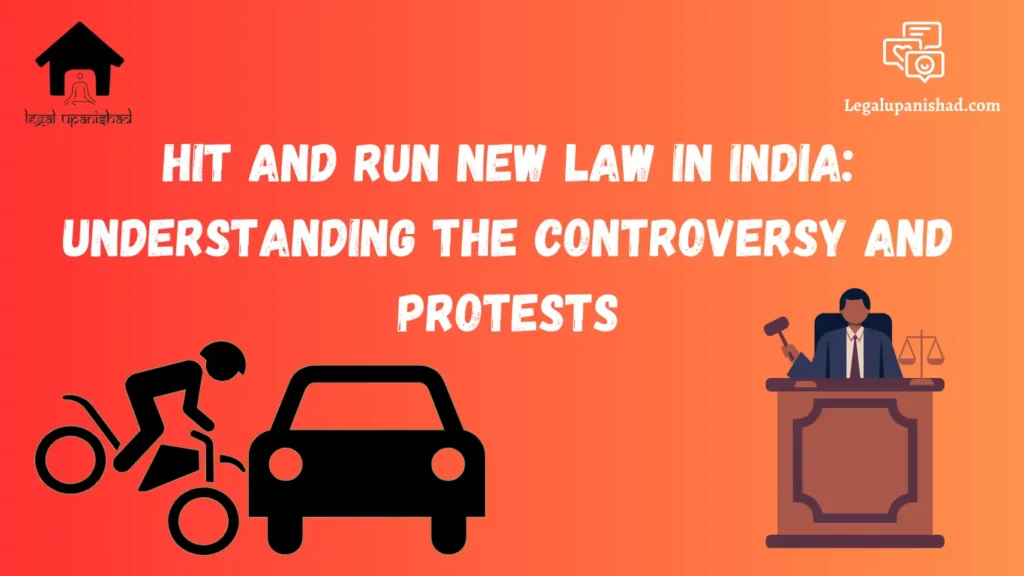This article on ‘New Hit and Run Law in India: Understanding the Controversy and Protests’ was written by Tosani Lal, an intern at Legal Upanishad.
I. INTRODUCTION
Hit and run refers to the act of a driver causing an accident and fleeing the scene without providing assistance or identifying themselves.[1] The action is widely condemned due to its potentially severe consequences for victims and the lack of accountability it entails. Hit and run incidents often result in serious injuries or fatalities, leaving victims and their families devastated.
The new hit and run law in India, implemented under the Bharatiya Nyaya Sanhita, also referred as (BNS), has introduced stringent penalties for offenders. This law aims to address the issue of hit and run incidents by imposing harsh punishments to deter such behavior and ensure accountability. The law represents a significant shift from previous legislation, signaling the government’s commitment to promoting road safety and holding drivers accountable for their actions.[2]
The law has sparked controversy and protests across India due to concerns about its fairness, enforcement, and potential impact on drivers and road safety.[3] Various stakeholders, including drivers’ associations, legal experts, and activists, have raised objections to certain provisions of the law, leading to widespread debate and demonstrations. The protests reflect a broader societal concern about the balance between accountability for drivers and the protection of their rights.[4]
II. BACKGROUND OF HIT AND RUN LAWS IN INDIA
Previous legislation regarding hit and run accidents under the Indian Penal Code (IPC) provided relatively lenient penalties compared to the new law. Offenders often faced limited jail time and fines, which were perceived as inadequate to deter such reckless behavior. The inadequacy of the previous laws led to calls for reform and stronger measures to address hit and run incidents.[5]
The introduction of the new hit and run law was driven by the need for stricter penalties to address the rising number of hit and run incidents in India. Lawmakers aimed to send a strong message to potential offenders and ensure justice for victims and their families. The new law represents a comprehensive effort to tackle hit and run incidents by imposing harsher penalties and strengthening legal obligations for drivers.[6]
A comparison between the old and new laws highlights significant changes in penalties and legal obligations. The new law under the BNS imposes harsher punishments, including longer jail terms and higher fines, to hold offenders accountable for their actions. Additionally, the law introduces new legal obligations for drivers involved in hit and run incidents, emphasizing the importance of reporting such incidents promptly to authorities.[7]
III. UNDERSTANDING THE NEW LAW
Key provisions of the new hit and run law include Section 106(2) of the BNS, which outlines penalties for offenders. This section stipulates that individuals who cause death due to negligent driving and flee the scene may face imprisonment for up to 10 years and fines. The law aims to deter hit and run incidents by imposing severe consequences for offenders, thereby promoting accountability and road safety.[8]
Penalties and punishments outlined in the law aim to act as deterrents against hit and run incidents. By imposing stricter penalties, lawmakers seek to discourage drivers from fleeing the scene of accidents and ensure that they take responsibility for their actions. The severity of the penalties reflects the government’s commitment to promoting road safety and protecting the rights of victims.[9]
Legal obligations of drivers involved in hit and run accidents emphasize the importance of reporting incidents to authorities promptly.[10] Failure to do so may result in harsh penalties under the law, highlighting the need for drivers to fulfill their legal obligations and cooperate with law enforcement agencies. By reporting accidents promptly, drivers can help ensure that victims receive timely medical assistance and that justice is served.[11]
IV. CONTROVERSIES SURROUNDING THE NEW LAW
Criticisms of the law from various stakeholders have centered on its perceived fairness and effectiveness.[12] Legal experts, activists, and members of the general public have raised concerns about potential loopholes or shortcomings in the law. Some argue that the law may disproportionately impact certain groups of drivers or fail to address the root causes of hit and run incidents.[13]
Analysis of potential loopholes or shortcomings in the law has highlighted areas of ambiguity or inconsistency that may undermine its effectiveness. Concerns have been raised about the practical challenges of enforcing the law and ensuring fair treatment for drivers. Critics argue that the law may inadvertently punish drivers who flee the scene out of fear for their safety, rather than malice or negligence.
Concerns regarding enforcement and implementation have been voiced, particularly regarding the fear of mob violence and the practical challenges faced by drivers. Some drivers may be compelled to flee the scene out of fear for their safety, raising questions about the law’s efficacy in addressing the root causes of hit and run incidents. Critics argue that the law may exacerbate tensions between drivers and law enforcement agencies, leading to potential conflicts and abuses of power.
V. PROTESTS AGAINST THE NEW LAW
An Overview of protests organized against the new hit and run law includes strikes and demonstrations by drivers’ associations and other concerned groups. These protests have highlighted widespread opposition to certain provisions of the law and the need for revisions. Drivers and activists have called for amendments to address concerns about fairness, enforcement, and potential unintended consequences.[14]
Reasons behind the protests include opposition to harsh penalties and concerns about the law’s fairness and practicality. Drivers and activists argue that the law may disproportionately impact certain groups of drivers or fail to address the root causes of hit and run incidents. The protests reflect a broader dissatisfaction with the government’s approach to road safety and driver accountability.[15]
The impact of protests on public opinion and government response has been significant, prompting authorities to engage in dialogue with stakeholders and consider potential revisions to the law. The protests have underscored the importance of public discourse and engagement in shaping legislation and policies related to road safety. By voicing their concerns and advocating for change, drivers and activists have played a crucial role in shaping the public debate on hit and run legislation.[16]


VI. LEGAL AND SOCIAL IMPLICATIONS
Potential effects of the new law on road safety include its deterrent effect on hit and run incidents. By imposing stricter penalties, lawmakers aim to reduce the occurrence of such accidents and promote safer driving practices. The severity of the penalties reflects the government’s commitment to protecting public safety and holding drivers accountable for their actions.[17]
Examination of the law’s impact on victims and their families highlights the need for justice and support for those affected by hit and run incidents. The law seeks to ensure that offenders are held accountable for their actions and that victims receive the compensation and assistance they deserve. By providing victims with access to justice and support services, the law aims to address the long-term consequences of hit and run incidents and promote healing and recovery.[18]
Discussion of broader societal implications includes considerations of the balance between accountability and drivers’ rights. The law’s enforcement and implementation may have far-reaching consequences for the transportation sector and public safety, underscoring the importance of careful deliberation and consideration of all stakeholders’ perspectives. By addressing concerns about fairness, enforcement, and unintended consequences, policymakers can ensure that the law achieves its intended objectives while respecting the rights and dignity of drivers.[19]
VII. GOVERNMENT RESPONSE AND FUTURE OUTLOOK
Measures taken by the government to address criticisms and protests include assurances of consultation with stakeholders and consideration of potential revisions to the law. Authorities have emphasized the importance of public input and engagement in shaping legislation related to road safety. By listening to the concerns of drivers and activists, the government can build trust and confidence in its approach to hit and run legislation.[20]
Reference List
[1] Hit-and-run, available at , www.dictionary.cambridge.org/dictionary/english/hit-and-run (last visited on 23 February 2024)
[2] Behind The Protests Examining The Controversial Hit And Run Laws Under Bharatiya Nyaya Sanhita, available at , www.logisticsinsider.in/behind-the-protests-examining-the-controversial-hit-and-run-laws-under-bharatiya-nyaya-sanhita/#:~:text=Under%20the%20new%20Bharatiya%20Nyaya,under%20the%20Indian%20Penal%20Code. (last visited on 23 February 2024)
[3] Protesting New Hit And Run Law Truckers Dial Down After Talks With Home Secretary, availavle at , www.indianexpress.com/article/india/protesting-new-hit-and-run-law-truckers-dial-down-after-talks-with-home-secretary-9092655/(last visited on 23 February 2024)
[4] Ibid
[5] Understanding the controversy surrounding hit and run provision under BNS , avialble at www.livelaw.in/top-stories/understanding-the-controversy-surrounding-hit-and-run-provision-under-bns-245734?infinitescroll=1 (last visited on 23 February 2024)
[6] Behind The Protests Examining The Controversial Hit And Run Laws Under Bharatiya Nyaya Sanhita, available at , www.logisticsinsider.in/behind-the-protests-examining-the-controversial-hit-and-run-laws-under-bharatiya-nyaya-sanhita/#:~:text=Under%20the%20new%20Bharatiya%20Nyaya,under%20the%20Indian%20Penal%20Code. (last visited on 24 February 2024)
[7] Understanding the controversy surrounding hit and run provision under BNS , avialble at www.livelaw.in/top-stories/understanding-the-controversy-surrounding-hit-and-run-provision-under-bns-245734?infinitescroll=1 (last visited on 24 February 2024)
[8] Ibid
[9] Behind The Protests Examining The Controversial Hit And Run Laws Under Bharatiya Nyaya Sanhita, available at , www.logisticsinsider.in/behind-the-protests-examining-the-controversial-hit-and-run-laws-under-bharatiya-nyaya-sanhita/#:~:text=Under%20the%20new%20Bharatiya%20Nyaya,under%20the%20Indian%20Penal%20Code. (last visited on 24 February 2024)
[10] Understanding the controversy surrounding hit and run provision under BNS , avialble at www.livelaw.in/top-stories/understanding-the-controversy-surrounding-hit-and-run-provision-under-bns-245734?infinitescroll=1 (last visited on 24 February 2024)
[11] Ibid
[12] Ibid
[13] Ibid
[14] Behind The Protests Examining The Controversial Hit And Run Laws Under Bharatiya Nyaya Sanhita, available at , www.logisticsinsider.in/behind-the-protests-examining-the-controversial-hit-and-run-laws-under-bharatiya-nyaya-sanhita/#:~:text=Under%20the%20new%20Bharatiya%20Nyaya,under%20the%20Indian%20Penal%20Code. (last visited on 24 February 2024)
[15] Ibid
[16] Ibid
[17] Protesting new hit and run law truckers dial down after talks with home secretary, available at (last visited on 24 February 2024)
[18] Ibid
[19] Ibid
[20] Ibid

